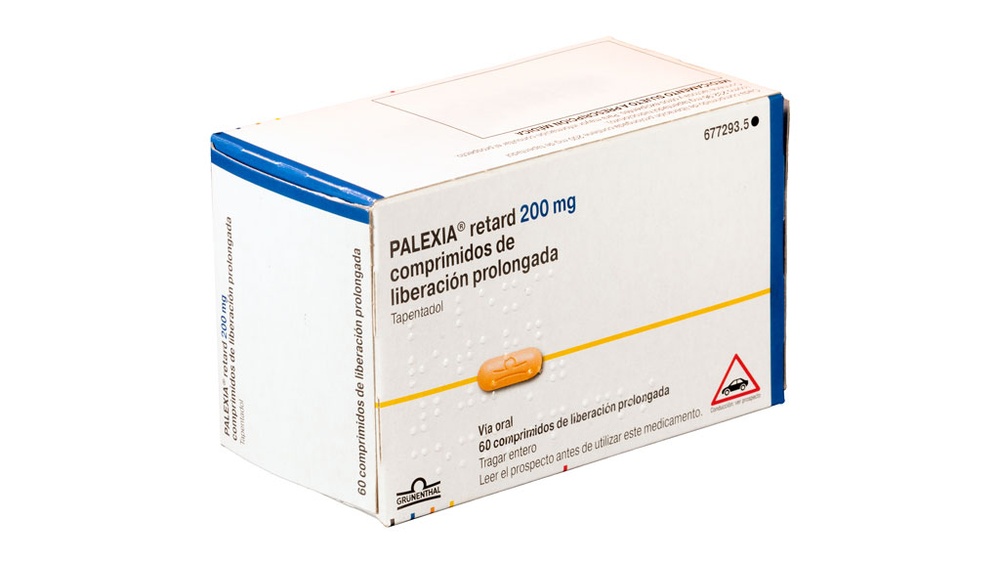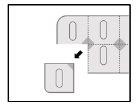

ПАЛГЕСІК РЕТАРД 200 мг ТАБЛЕТКИ ПРОДОВЖЕНОЇ ДІЇ

Запитайте лікаря про рецепт на ПАЛГЕСІК РЕТАРД 200 мг ТАБЛЕТКИ ПРОДОВЖЕНОЇ ДІЇ

Інструкція із застосування ПАЛГЕСІК РЕТАРД 200 мг ТАБЛЕТКИ ПРОДОВЖЕНОЇ ДІЇ
Введення
Опис: інформація для користувача
Палгезик ретард 25 мг пролонговані таблетки EFG
Палгезик ретард 50 мг пролонговані таблетки EFG
Палгезик ретард 100 мг пролонговані таблеткиEFG
Палгезик ретард 150 мг пролонговані таблетки EFG
Палгезик ретард 200 мг пролонговані таблетки EFG
Палгезик ретард 250 мг пролонговані таблетки EFG
тапентадол
Прочитайте уважно весь опис перед початком прийому цього лікарського засобу, оскільки він містить важливу інформацію для вас.
- Збережіть цей опис, оскільки вам може знадобитися знову його прочитати.
- Якщо у вас виникли питання, проконсультуйтеся з вашим лікарем або фармацевтом.
- Цей лікарський засіб призначений тільки вам, і не давайте його іншим людям, навіть якщо вони мають такі ж симптоми, як і ви, оскільки це може їм нашкодити.
- Якщо ви відчуваєте побічні ефекти, проконсультуйтеся з вашим лікарем або фармацевтом, навіть якщо це побічні ефекти, які не вказані в цьому описі. Див. розділ 4.
Зміст опису
- Що таке Палгезик ретард і для чого він використовується
- Що потрібно знати перед початком прийому Палгезик ретарду
- Як приймати Палгезик ретард
- Можливі побічні ефекти
- Збереження Палгезик ретарду
- Зміст упаковки та додаткова інформація
1. Що таке Палгезик ретард і для чого він використовується
Тапентадол - активна речовина Палгезик ретарду - є потужним анальгетиком, який належить до класу опіоїдів.
Тапентадол використовується для лікування хронічного сильного болю у дорослих, який можна адекватно лікувати тільки опіоїдним анальгетиком.
2. Що потрібно знати перед початком прийому Палгезик ретарду
Не приймайте Палгезик ретард
- якщо ви алергічні на тапентадол або на інші компоненти цього лікарського засобу (перелічені в розділі 6),
- якщо у вас є астма або якщо ваша дихання повільне або недостатньо глибоке до небезпечного рівня [депресія дихання; гіперкапнія (збільшення рівня вуглекислого газу в крові)],
- якщо у вас є захворювання, при якому кишечник не функціонує належним чином (параліч кишечника),
- якщо ви вживали алкоголь, снодійні таблетки, інші анальгетики або інші психотропні лікарські засоби (лікарські засоби, які впливають на настрій і емоції) у високих дозах (див. розділ "Інші лікарські засоби та тапентадол").
Попередження та застереження
Проконсультуйтеся з вашим лікарем або фармацевтом перед початком прийому тапентадолу:
- якщо ваше дихання повільне або недостатньо глибоке,
- якщо у вас підвищений тиск у головному мозку або порушення свідомості аж до коми,
- якщо у вас був черепно-мозковий травматизм або пухлини головного мозку,
- якщо у вас є захворювання печінки або нирок (див. розділ "Як приймати Палгезик ретард"),
- якщо у вас є захворювання підшлункової залози (наприклад, запалення підшлункової залози) або жовчних шляхів,
- якщо ви приймаєте лікарські засоби, які називаються змішаними агоністами/антагоністами опіоїдних рецепторів μ (наприклад: пентазоцін, налбуфін) або частковими агоністами опіоїдних рецепторів μ (наприклад, бупренорфін),
- якщо ви схильні до епілепсії або судом, або якщо ви приймаєте інші лікарські засоби, які мають відомий ризик збільшення судом, оскільки ризик цих криз може збільшитися,
- якщо ви або члени вашої родини мали випадки зловживання алкоголем, лікарськими засобами або забороненими речовинами ("залежність"),
- якщо ви палите,
- якщо ви раніше мали проблеми з настроєм (депресія, тривога або розлад особистості) або проходили лікування у психіатра для інших психічних захворювань.
Цей лікарський засіб містить тапентадол, який є опіоїдним лікарським засобом. Повторне використання опіоїдних анальгетиків може зменшити їхню ефективність (ви можете звикнути до них). Також це може призвести до залежності та зловживання, що може привести до потенційно смертельної передозування. важливо повідомити вашому лікареві, якщо ви думаєте, що можете мати залежність від тапентадолу. Його використання (навіть у терапевтичних дозах) може призвести до фізичної залежності, що може призвести до того, що ви відчуватимете симптоми відміни та повторення проблем, якщо раптово припините приймати цей лікарський засіб.
Тапентадол може призвести до фізичної та психологічної залежності. Якщо ви схильні до зловживання лікарськими засобами або маєте залежність від лікарських засобів, ви повинні приймати ці таблетки тільки протягом короткого періоду під суворим медичним наглядом.
Респіраторні розлади, пов'язані з сном
Тапентадол може призвести до респіраторних розладів, пов'язаних з сном, таких як апное сну (перерва в диханні під час сну) та гіпоксемія, пов'язана з сном (низький рівень кисню в крові). Симптоми можуть включати перерви в диханні під час сну, нічні пробудження через труднощі з диханням, труднощі з підтриманням сну або надмірна сонливість вдень. Якщо ви або інша людина спостерігають ці симптоми, проконсультуйтеся з вашим лікарем. Ваш лікар може вирішити зменшити дозу.
Інші лікарські засоби та тапентадол
Повідоміть вашому лікареві або фармацевту, якщо ви приймаєте, нещодавно приймали або можете приймати інші лікарські засоби.
Ризик побічних ефектів збільшується, якщо ви приймаєте лікарські засоби, які можуть призвести до судом (наприклад, деякі антидепресанти або антипсихотичні лікарські засоби). Ризик судом збільшується, якщо ви приймаєте тапентадол одночасно з цими лікарськими засобами. Ваш лікар скаже вам, чи підходить тапентадол для вас.
Сумісне використання тапентадолу та седативних лікарських засобів, таких як бензодіазепіни або пов'язані з ними лікарські засоби (деякі снодійні таблетки або транквілізатори [наприклад, барбітурати] або анальгетики, такі як опіоїди, морфін і кодеїн [також як лікарський засіб для кашлю], антипсихотичні лікарські засоби, антигістамінні лікарські засоби H1, алкоголь), збільшує ризик сонливості, респіраторних труднощів (депресія дихання), коми та може бути потенційно смертельним. Через це сумісне використання повинно розглядатися тільки тоді, коли немає інших варіантів лікування.
Однак, якщо ваш лікар призначає вам тапентадол з седативними лікарськими засобами, він повинен обмежити дозу та тривалість сумісного лікування.
Сумісне використання опіоїдів та лікарських засобів, які використовуються для лікування епілепсії, невропатичного болю або тривоги (габапентин та прегабалін), збільшує ризик передозування опіоїдів, депресії дихання та може бути потенційно смертельним.
Повідоміть вашому лікареві, якщо ви приймаєте габапентин або прегабалін або інші седативні лікарські засоби, та дотримуйтесь інструкцій вашого лікаря щодо дозування. Це може бути корисним, якщо ви повідомите друзів або членів родини, щоб вони були обізнані про ці симптоми. Зв'яжіться з вашим лікарем, якщо ви відчуваєте ці симптоми.
Якщо ви приймаєте лікарські засоби, які впливають на рівень серотоніну (наприклад, деякі лікарські засоби для лікування депресії), проконсультуйтеся з вашим лікарем перед прийомом тапентадолу, оскільки були випадки "серотонінового синдрому". Серотоніновий синдром - це рідке, але потенційно смертельне захворювання. Симптоми можуть включати мимовільні ритмічні скорочення м'язів, включаючи м'язи, які контролюють рух очей, агітацію, надмірне потіння, тремор, підвищені рефлекси, підвищення м'язового тонусу та підвищення температури тіла понад 38 °C. Ваш лікар може надати вам додаткову інформацію.
Не було проведено дослідження щодо сумісного використання тапентадолу з іншими лікарськими засобами, які називаються змішаними агоністами/антагоністами опіоїдних рецепторів μ (наприклад: пентазоцін, налбуфін) або частковими агоністами опіоїдних рецепторів μ (наприклад, бупренорфін). Можливо, тапентадол не матиме такої ж ефективності, якщо його приймати одночасно з цими лікарськими засобами. Повідоміть вашому лікареві, якщо ви зараз приймаєте один з цих лікарських засобів.
Сумісне використання тапентадолу та потужних інгібіторів або індукторів (наприклад, рифампіцину, фенобарбіталу, трави святого Івана) певних ферментів, які необхідні для виведення тапентадолу з вашого організму, може вплинути на ефективність тапентадолу або призвести до побічних ефектів, особливо коли починається або припиняється прийом цих лікарських засобів. Інформуйте вашого лікаря про всі лікарські засоби, які ви приймаєте.
Тапентадол не повинен прийматися одночасно з інгібіторами МАО (лікарські засоби для лікування депресії). Повідоміть вашому лікареві, якщо ви приймаєте інгібітори МАО або якщо ви приймали їх протягом останніх 14 днів.
Прийом тапентадолу з їжею, напоями та алкоголем
Не вживайте алкоголь під час прийому тапентадолу, оскільки деякі з його побічних ефектів, таких як сонливість, можуть збільшитися. Прийом їжі не впливає на дію цього лікарського засобу.
Вагітність та лактація
Якщо ви вагітні або годуєте грудьми, вважаєте, що можете бути вагітною або плануєте вагітність, проконсультуйтеся з вашим лікарем або фармацевтом перед прийомом цього лікарського засобу.
Не приймайте цей лікарський засіб:
- якщо ви вагітні, якщо тільки ваш лікар не призначив його вам, якщо тапентадол використовується протягом тривалого періоду під час вагітності, він може призвести до симптомів відміни у новонародженого, що може загрожувати життю новонародженого, якщо це не буде виявлено та лікувано лікарем,
- під час пологів, оскільки він може призвести до повільного або недостатнього дихання у новонародженого (депресія дихання),
- під час годування грудьми, оскільки він може виділятися з грудним молоком.
Водіння автомобіля та використання машин
Спитайте вашого лікаря, чи можете ви водити автомобіль або використовувати машини під час лікування тапентадолом. важливо спостерігати, як цей лікарський засіб впливає на вас. Не водьте автомобіль та не використовуйте машини, якщо ви відчуваєте сонливість, головокружіння, маєте розмитий зір або маєте труднощі з концентрацією уваги. Будьте особливо обережні на початку лікування, після зміни дози та при сумісному прийомі з алкоголем або седативними лікарськими засобами.
3. Як приймати Палгезик ретард
Слідуйте точно інструкціям щодо прийому цього лікарського засобу, які вказані вашим лікарем або фармацевтом. Якщо у вас виникли питання, проконсультуйтеся з вашим лікарем або фармацевтом.
Ваш лікар відрегулює дозу залежно від інтенсивності вашого болю та вашої особистої чутливості до болю. Зазвичай потрібно приймати мінімально ефективну дозу для полегшення болю.
Таблетку можна розділити на дві рівні частини.
Дорослі
Рекомендована доза становить 1 таблетку кожні 12 годин. Не рекомендується приймати добову дозу понад 500 мг тапентадолу.
Можливо, ваш лікар призначить вам іншу дозу або інший режим прийому, якщо це необхідно. Якщо ви вважаєте, що дія цих таблеток надто сильна або надто слабка, проконсультуйтеся з вашим лікарем або фармацевтом.
Пацієнти похилого віку
У пацієнтів похилого віку (старших 65 років) зазвичай не потрібно коригувати дозу. Однак виведення тапентадолу може бути сповільненим і повільнішим у деяких пацієнтів цієї вікової групи. Якщо це стосується вас, ваш лікар може призначити інший режим прийому.
Захворювання печінки та нирок (непрацездатність печінки та нирок)
Пацієнти з тяжкими захворюваннями печінки не повинні приймати ці таблетки. Якщо у вас є помірні захворювання печінки, ваш лікар призначить інший режим прийому. Якщо у вас є легкі захворювання печінки, не потрібно коригувати дозу.
Пацієнти з тяжкими захворюваннями нирок не повинні приймати ці таблетки. Якщо у вас є легкі або помірні захворювання нирок, не потрібно коригувати дозу.
Використання у дітей та підлітків
Тапентадол не призначений для дітей та підлітків молодших 18 років.
Як і коли приймати тапентадол
Тапентадол повинен прийматися перорально.
Всегда приймайте таблетки з достатньою кількістю рідини.
Ви можете приймати таблетки цілими або розділеними на дві частини по рисці. Не жуйте та не розтиrajte їх, оскільки це може призвести до передозування, оскільки активна речовина буде вивільнена в вашому організмі надто швидко.
Ви можете приймати таблетки натще (з порожнім шлунком) або з їжею.
Покриття таблетки може не бути повністю розчинено і, отже, може з'явитися, здавалося б, незміненим, у ваших випорожненнях. Це не повинно вас турбувати, оскільки активна речовина таблетки вже була абсорбована вашим організмом, а те, що ви бачите, - це тільки порожнє покриття.
Інструкції з відкриття блистеру
Цей лікарський засіб упакований у блистери з попередньо вирізаними однодозовими упаковками, що мають захист від дітей. Ви не можете витиснути таблетку з блистера. Будь ласка, дотримуйтесь наступних інструкцій з відкриття блистера:
- Виріжте одну дозу уздовж попередньо вирізаних ліній блистера.

- Знайдіть незакриту ділянку, яка знаходиться там, де попередньо вирізані лінії перетинаються.

- Потягніть за незакриту ділянку, щоб відокремити плівку

Як довго потрібно приймати тапентадол
Не приймайте таблетки довше, ніж вказав ваш лікар.
Якщо ви прийняли надто багато тапентадолу
Після прийому дуже високих доз ви можете відчувати деякі з наступних ефектів:
- дуже маленькі зіниці, нудота, зниження артеріального тиску, прискорене серцебиття, непритомність, порушення свідомості або кома (глибоке порушення свідомості), судоми, повільне або недостатнє дихання аж до небезпечного рівня або зупинки дихання.
Якщо ви відчуваєте будь-які з цих ефектів, негайно зверніться до лікаря!
У разі передозування або випадкового прийому проконсультуйтеся з вашим лікарем або фармацевтом або зверніться до служби токсикологічної інформації, телефон: 91 562 04 20, вказавши лікарський засіб та кількість, що була використана. Рекомендується взяти з собою упаковку та опис лікарського засобу до медичного працівника.
Якщо ви забули прийняти тапентадол
Якщо ви забули прийняти одну таблетку, ймовірно, ви знову відчуєте біль. Не приймайте подвійну дозу, щоб компенсувати забуті дози, а продовжуйте приймати таблетки, як раніше.
Якщо ви припиняєте лікування тапентадолом
Якщо ви припиняєте або закінчуєте лікування занадто рано, ймовірно, ви знову відчуєте біль. Якщо ви бажаєте припинити лікування, проконсультуйтеся з вашим лікарем перед тим, як це зробити.
Зазвичай пацієнти не відчувають жодних побічних ефектів після припинення лікування, але в рідких випадках особи, які приймали таблетки протягом довгого часу, можуть відчувати себе погано, якщо раптово припинять приймати їх.
Симптоми можуть включати:
- нервозність, слізливість, насморк, зевання, потіння, озноб, м'язовий біль та розширені зіниці,
- ірритація, тривога, біль у спині, суглобовий біль, слабкість, м'язові спазми, труднощі з сном, нудота, зниження апетиту, блювота, діарея та підвищення артеріального тиску, частоти дихання або серцебиття.
Якщо ви відчуваєте будь-які з цих симптомів після припинення лікування, проконсультуйтеся з вашим лікарем.
Не припиняйте приймати цей лікарський засіб раптово, якщо тільки ваш лікар не вказав вам це зробити. Якщо ваш лікар хоче, щоб ви припинили приймати ці таблетки, він покаже вам, як це зробити, що може включати поступове зменшення дози.
Якщо у вас є будь-які інші питання щодо використання цього лікарського засобу, проконсультуйтеся з вашим лікарем або фармацевтом.
4. Можливі побічні ефекти
Як і всі лікарські засоби, цей лікарський засіб може викликати побічні ефекти, хоча не всі люди їх переживають.
Побічні ефекти або симптоми, на які потрібно звернути увагу і що робити, якщо ви ними постраждали:
Цей лікарський засіб може викликати алергічні реакції. Симптоми можуть полягати у свистячому диханні (виді свисту при диханні), труднощах з диханням, запаленні повік, обличчя або губ, висипі на шкірі або свербінні, особливо якщо вони впливають на все тіло.
Іншим серйозним побічним ефектом є повільніше або слабше дихання, ніж зазвичай. Це відбувається в основному у пацієнтів похилого віку або у пацієнтів з ослабленою імунною системою.
Якщо ви відчуваєте будь-які з цих важливих симптомів, зверніться до свого лікаря негайно.
Інші побічні ефекти, які можуть виникнути:
Дуже часті(можуть вплинути на більше 1 з 10 осіб): нудота, запор, головокружіння, сонливість, головний біль.
Часті(можуть вплинути до 1 з 10 осіб): зниження апетиту, тривога, депресія настрою, труднощі з сном, нервозність, безсоння, порушення уваги, тремор, м'язові тики, приливи, задишка, блювота, діарея, погана травлення, свербіння, підвищена пітливість, висипи на шкірі, відчуття слабкості, втоми, відчуття зміни температури тіла, сухість слизових оболонок, накопичення води в тканинах (едем).
Рідкі(можуть вплинути до 1 з 100 осіб): алергічна реакція на лікарські засоби (включаючи набряк під шкірою, кропив'янку і в тяжких випадках труднощі з диханням, зниження артеріального тиску, колапс або шок), втрату ваги, дезорієнтацію, сплутаність, збудження (агітацію), порушення сприйняття, порушення сну, еуфорію, депресію 
Рідкісні(можуть вплинути до 1 з 1000 осіб): залежність від лікарського засобу, порушення мислення, епілептичні припадки, відчуття передчуття знепритомнення, порушення координації, повільне або поверхневе дихання до небезпечного рівня (респіраторна депресія), порушення евакуації шлунка, відчуття оп'яνανня, відчуття розслаблення.
Частота невідома(не може бути оцінена на основі доступних даних): делірій.
Загалом, можливість мати думки і поведінку, пов'язану з самогубством, збільшується у пацієнтів з хронічним болем. Крім того, деякі лікарські засоби для лікування депресії (з впливом на систему нейротрансмітерів мозку) можуть збільшити цей ризик, особливо на початку лікування. Хоча тапентадол також впливає на нейротрансмітери, через досвід у пацієнтів не було доведено, що він збільшує цей ризик.
Повідомлення про побічні ефекти
Якщо ви відчуваєте будь-який побічний ефект, зверніться до свого лікаря або фармацевта, навіть якщо це можливо побічні ефекти, які не вказані в цьому листку. Ви також можете повідомити про них безпосередньо через Іспанську систему фармакологічного нагляду за лікарськими засобами для людини: https://www.notificaram.es. За допомогою повідомлення про побічні ефекти ви можете допомогти надати більше інформації про безпеку цього лікарського засобу.
5. Зберігання Палгезика ретард
Тримайте цей лікарський засіб поза зоною видимості та доступу дітей.
Не використовуйте цей лікарський засіб після закінчення терміну придатності, вказаного на коробці та блистерній упаковці після CAD. Термін придатності - останній день місяця, вказаного на упаковці.
Цьому лікарському засобу не потрібні спеціальні умови зберігання.
Лікарські засоби не повинні викидатися у водопровідні труби чи сміття. Відкладайте упаковки та лікарські засоби, які вам не потрібні, у пункт збору фармацевтичного сміття. Спитайте у свого фармацевта, як позбутися упаковок та лікарських засобів, які вам не потрібні. Таким чином, ви допоможете захистити довкілля.
6. Зміст упаковки та додаткова інформація
Склад Палгезика ретард
Активний інгредієнт - тапентадол.
Палгезик ретард 25 мг пролонговані таблетки EFG
Кожна пролонгована таблетка містить 25 мг тапентадолу (у вигляді фосфату).
Палгезик ретард 50 мг пролонговані таблетки EFG
Кожна пролонгована таблетка містить 50 мг тапентадолу (у вигляді фосфату).
Палгезик ретард 100 мг пролонговані таблетки EFG
Кожна пролонгована таблетка містить 100 мг тапентадолу (у вигляді фосфату).
Палгезик ретард 150 мг пролонговані таблетки EFG
Кожна пролонгована таблетка містить 150 мг тапентадолу (у вигляді фосфату).
Палгезик ретард 200 мг пролонговані таблетки EFG
Кожна пролонгована таблетка містить 200 мг тапентадолу (у вигляді фосфату).
Палгезик ретард 250 мг пролонговані таблетки EFG
Кожна пролонгована таблетка містить 250 мг тапентадолу (у вигляді фосфату).
Інші складові частини (експіцієнти) -:
- Ядро таблетки: мікрокристалічна целюлоза, гіпромелоза, колоїдна діоксид кремнію, стеарат магнію.
- Покриття таблетки: гіпромелоза, гліцерол, тальк, мікрокристалічна целюлоза, діоксид титану (E 171),
оксид заліза червоний (E172) (тільки для доз 25, 100, 150, 200 і 250 мг), оксид заліза жовтий (E172) (тільки для доз 25, 100 і 200 мг), оксид заліза чорний (E172) (тільки для доз 25, 100, 150, 200 і 250 мг).
Вигляд Палгезика ретард та вміст упаковки
Палгезик ретард 25 мг пролонговані таблетки EFG:таблетки, покриті плівкою, коричневого кольору, овальні, двовигнуті (5,7 мм х 12,2 мм), з виїмкою на обох сторонах.
Палгезик ретард 50 мг пролонговані таблетки EFG:таблетки, покриті плівкою, білого кольору, овальні, двовигнуті (6,2 мм х 13,2 мм), з виїмкою на обох сторонах.
Палгезик ретард 100 мг пролонговані таблетки EFG:таблетки, покриті плівкою, жовтого кольору, овальні, двовигнуті (6,7 мм х 14,2 мм), з виїмкою на обох сторонах.
Палгезик ретард 150 мг пролонговані таблетки EFG:таблетки, покриті плівкою, червоного кольору, овальні, двовигнуті (7,2 мм х 15,2 мм), з виїмкою на обох сторонах.
Палгезик ретард 200 мг пролонговані таблетки EFG:таблетки, покриті плівкою, жовтого кольору, овальні, двовигнуті (7,7 мм х 16,2 мм), з виїмкою на обох сторонах.
Палгезик ретард 250 мг пролонговані таблетки EFG:таблетки, покриті плівкою, коричневого кольору, овальні, двовигнуті (8,7 мм х 18,2 мм), з виїмкою на обох сторонах.
Доступні в упаковках по 60 одиниць, упакованих у блистерні упаковки з алюмінію-ПВХ/ПЕ/ПВДК, захищені від дітей.
Власник дозволу на розповсюдження
Kern Pharma, S.L.
Venus, 72 - Промзона Колон II
08228 Террасса – Барселона
Іспанія
Виробник
Develco Pharma GmbH
Грієнматт 27
79650 Шопфгайм
Німеччина
Дата останнього перегляду цього листка: Серпень 2023
Детальна інформація про цей лікарський засіб доступна на сайті Іспанського агентства лікарських засобів і медичних продуктів (AEMPS) (http://www.aemps.gob.es/)

Скільки коштує ПАЛГЕСІК РЕТАРД 200 мг ТАБЛЕТКИ ПРОДОВЖЕНОЇ ДІЇ в Іспанії у 2026 році?
ПАЛГЕСІК РЕТАРД 200 мг ТАБЛЕТКИ ПРОДОВЖЕНОЇ ДІЇ коштує в середньому 88.05 євро у січень, 2026 році. Ціна може змінюватися залежно від регіону, аптеки та наявності рецепта. Рекомендуємо перевіряти актуальну вартість у місцевих аптеках або через онлайн-сервіси.
- Країна реєстрації
- Середня ціна в аптеках88.05 EUR
- Діючі речовини
- Потрібен рецептТак
- Виробник
- Інформація є довідковою і не є медичною порадою. Перед прийомом будь-яких препаратів обов'язково проконсультуйтеся з лікарем. Oladoctor не несе відповідальності за медичні рішення, прийняті на основі цього контенту.
- Альтернативи до ПАЛГЕСІК РЕТАРД 200 мг ТАБЛЕТКИ ПРОДОВЖЕНОЇ ДІЇФорма випуску: ТАБЛЕТКА З МОДИФІКОВАНИМ ВИВІЛЬНЕННЯМ, 100 мгДіючі речовини: tapentadolВиробник: Sandoz Farmaceutica S.A.Потрібен рецептФорма випуску: ТАБЛЕТКА З МОДИФІКОВАНИМ ВИВІЛЬНЕННЯМ, 150 мгДіючі речовини: tapentadolВиробник: Sandoz Farmaceutica S.A.Потрібен рецептФорма випуску: ТАБЛЕТКА З МОДИФІКОВАНИМ ВИВІЛЬНЕННЯМ, 200 мгДіючі речовини: tapentadolВиробник: Sandoz Farmaceutica S.A.Потрібен рецепт
Аналоги ПАЛГЕСІК РЕТАРД 200 мг ТАБЛЕТКИ ПРОДОВЖЕНОЇ ДІЇ в інших країнах
Найкращі аналоги з тією самою діючою речовиною та терапевтичним ефектом.
Аналог ПАЛГЕСІК РЕТАРД 200 мг ТАБЛЕТКИ ПРОДОВЖЕНОЇ ДІЇ у Polska
Аналог ПАЛГЕСІК РЕТАРД 200 мг ТАБЛЕТКИ ПРОДОВЖЕНОЇ ДІЇ у Ukraina
Лікарі онлайн щодо ПАЛГЕСІК РЕТАРД 200 мг ТАБЛЕТКИ ПРОДОВЖЕНОЇ ДІЇ
Консультація щодо дозування, побічних ефектів, взаємодій, протипоказань та поновлення рецепта на ПАЛГЕСІК РЕТАРД 200 мг ТАБЛЕТКИ ПРОДОВЖЕНОЇ ДІЇ – за рішенням лікаря та згідно з місцевими правилами.














